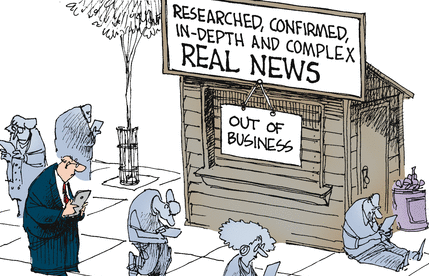Gannett, America’s largest newspaper chain, should wake up each morning thankful for the existence of No. 2 Alden Global Capital.
It’s the type of company that inspires debates over whether “vulturous” is too kind of an adjective. If you’re writing an Atlantic cover story on “Who Killed America’s Newspapers?” Alden Global Capital will hand you the murder weapon, already dusted for prints.
Gannett, meanwhile, is at least a newspaper company, one more than a century old. It’s rarely been considered a particularly good one, mind you…
By December 31, 2019, the combined company was down to 21,255 employees in the U.S. By the end of 2020, that had dropped to 18,141. A year later: 13,800. And its most recent SEC filing reports that, as of the end of 2022, Gannett had just 11,200 U.S. employees remaining
MediaPost reports Gannett disagrees with some of the circulation figures in the NiemanLab article:
After the article appeared, Gannett responded, “A recent Nieman Lab article utilizes Alliance for Audited Media (AAM) data to inaccurately depict Gannett’s circulation and subscriber figures. We have requested a correction.
Benton added this to the article: “A mea culpa. I originally referred in this section to ‘paying readers’ and ‘paid readership’ when quoting the circulation numbers Gannett (and other companies) file with the Alliance for Audited Media…
Gannett did not dispute the employment figures.

Brier Dudley at The Seattle Times sees a glimmer of hope in the Gannett report:
Those concerned about saving local journalism should note another revelation in Gannett’s report, one suggesting that there’s an opportunity for communities to restore their local newspaper.
During its Feb. 23 earnings call, CEO Michael Reed said the company is open to selling off local papers, if buyers step forward with a reasonable offer.
Reed’s comments suggest there are many more opportunities to salvage and rebuild Gannett cast-offs.
Maybe I’m overly optimistic about these papers’ potential and the number of communities that could find investors, syndicates or even charitable organizations to give them a fresh start.
But I believe there’s still a demand and need for these local papers…

Though another independent newspaper died, expanding the news desert.
From Nic Garcia for The Texas Tribune:
Thursday arrived as usual in the Texas Panhandle. But a new edition of The Canadian Record, this gritty town’s definitive source of local news for more than 130 years, did not come with it.
The green flag that told the townspeople that there was a new edition of the newspaper, usually 28 pages long and full of the words and photos of their neighbors and their neighbors’ kids, did not fly outside the weekly’s Main Street office.
The end of The Record’s print edition — even if temporary as Brown continues the search for a potential successor — offers a fresh reminder of how perilous the news business is for most local publishers and the communities they are part of.
Hemphill County will join a growing list of Texas counties without a newspaper if The Record ultimately stops publishing.
At least 27 counties — all of them rural — have no paper, according to a national study on the state of local news from the Local News Initiative at Northwestern University’s Medill School of Journalism. What replaces them, research has found, is a mix of misinformation, higher taxes, greater political polarization and lower voter turnout.

Feature image from Wiley Miller’s Non Sequitur

Newspapers have gone digital nowadays…sort of…
The digital New York Times went from $17 a month to $20 by the end of April. My wife and I subscribe to The Washington Post digital paper also, but we do get the physical Newark Star-Ledger paper from Thursday to Sunday. I don’t recall the monthly amount we pay, though. My wife wants to drop it, but I’m holding firm!
When I called the NY Times to cancel my subscription after the initial reduced rate expired, I told them I couldn’t afford the big increase. So they kept my rate at $4/mo. for digital subscription. I believe there is wiggle room for negotiating.
Same with the Washington Post. Our introductory digital rate has expired twice; when I tried to cancel online I was asked why and when I checked “introductory rate has expired” I was offered a steep discount for another year.
We pay for home delivery of the Sunday NYT; digital is free with that. Delivery often fails (they appear to use the same unreliable series of people as our Rochester NY Gannett paper) but they issue a credit that is more than buying a replacement copy costs at the grocery story.
I went back to college in 2016, at age 65, to get a business degree. For one class in the Advertising course I brought in copies of Smithsonian Magazine and the Boston Globe. The young students were fascinated, especially by the newspaper. It was like they had never actually seen one up close.
Since it was an Advertising course, we made notes of the advertisements in Smithsonian: A brokerage specializing in retirement funds. The state of Arizona. Shoes that alleviate foot pain. Recognize the signs of heart failure. A mechanical wristwatch. A hearing aid. Testosterone-boosting pills. A lift chair. Life Alert. A walk-in tub/shower. A “Jitterbug” phone. Affordable Medicare prescriptions.
My local Gannett paper no longer has a local reporter. We get national and state news, and commentary from a town a 3 hour drive away. They do run local obituaries though.
We really need to stop pretending that Gannett still exists in anything but name only: this is now just GateHouse parading around in the skin of the former newspaper chain like Buffalo Bill in Silence of the Lambs.